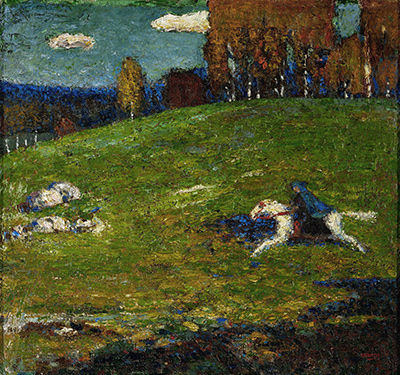Wassily Kandinsky was a Russian painter, who lived and worked in the latter half of the 19th and the first half of the 20th centuries.
He is most famed for painting one of the first ever abstract artworks. His life history is interesting, since he first graduated from Grekov Oredessa Art School, and later went on to study law and economics. However, he ultimately returned to his first love - painting - as a career.
Kandinsky's life also took some interesting turns. He first went to Germany to study art, but when he returned to Moscow after that, he discovered his ideas were not in tune with the official Communist ideas for art, and he decided to return to Germany. This only lasted till the Nazi regime rose up, after which Kandisky was forced to move to France, where he spent the rest of his life.
Kandinsky's first paintings were highly detailed and colourful. He gradually switched over to abstract act of which he was one of the pioneers. He was also a proponent of The Blue Rider movement, which lasted a mere four years, but which had a significant impact on German art. It is believed that name of the movement was taken from one of Kandisky's painting of the same name.
The Blue Rider, or Der Blaue Reiter, as the title was called in German, was one of Kandisky's last works in impressionism, but contains grains of abstractionism.
The painting is quite grainy, which is the first impression received on looking at it. The background appears to be vast with forests stretching out into the distance. The foreground is a beautiful meadow, bright with the lushness of green grass. Speeding across this landscape is a lone man on a white horse. The rider is wearing a blue coat or cloak, from which the name of the painting probably derives. It is however believed by some art theorists that the painting might have had a different name originally, since the title has been discovered to be overwritten over something else.
Kandisky had the habit of leaving open a lot of his artwork to interpretation. He enjoyed doing paintings that made art interactive with the viewers. In The Blue Rider, this is seen in the main subject of the painting, the horse and the rider. This part is not very clear and many art historians believe that there is a second figure on the horse, possibly a child. In this painting, the rider is not shown in detail at all but is more as a series of colours. The unclear depiction of the rider clearly shows Kandinsky's interest in abstractionism at this point.
The blue of the rider was considered a spiritual colour by Kandisky and might be a way of giving a spiritual overtone to this work. The horse and rider motif was used by Kandinsky in many of his works and possibly indicated a resistance to the conventional ideas of aesthetic appeal.
The Blue Rider is in itself not considered a very remarkable painting, but is an important link between post-impressionism and expressionism. It is hence considered one of the most important and decisive moment in Kandinsky's development as an artist. Painted in 1903, The Blue Rider is an oil on canvas painting. It is currently held in a private collection and not available for public viewing.




